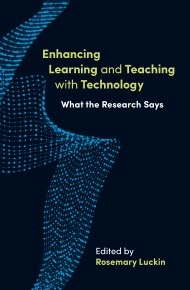
Enhancing Learning and Teaching with Technology: What the Research Says
Date Reviewed: September 6, 2018
Enhancing Learning and Teaching with Technology: What the Research Says
Rosemary Luckin, editor
London, UK: UCL Institute of Education Press, 2018 (xxxv + 334 pages, ISBN 978-1-78277-226-2, $41.95)
The overarching conclusion one might draw from this research-oriented review of current studies regarding education and technology is that we simply do not know enough about the effects of digital resources on teaching and learning. As the authors of this edited volume repeatedly point out, media reports about educational technology typically highlight negative findings and ignore positive associations. Technology champions and detractors rely primarily on face-value benefits or concerns in making their cases for or against educational use. Few studies have empirically considered the interplay among specific learning theories, educational contexts, embodied practices, and various technologies that might enhance learning. Without such research, we cannot draw defensible conclusions about the educational effectiveness of technology resources for formal and informal learning.
Organized in six parts – two that focus on learning factors and four related to educational challenges that might benefit from technological resourcing – the text is at times jargon heavy, particularly for readers unfamiliar with computer programming lingo or European educational policies and practices. A six-page glossary offsets some of this difficulty. Diagrams described as color-coded are printed in black and white, which complicates interpretation. Chapters are short (averaging seven or eight pages), so topics are covered succinctly with little detail to bolster analytic claims. Seven evidence-based learning principles are introduced (2-8) and referenced throughout the text, as are a list of nineteen learning approaches (see Table 2.1, 36). These frameworks serve to tie different case studies together. At the end of each section, the editor summarizes key findings in a bulleted list that can serve as a quick reference for readers.
The case studies provided focus primarily on school-age children and Science, Technology, Engineering, and Math (STEM) subjects or language development, although some chapters address adult learners. Most helpful for Reflective Teaching readers would be the discussions of video production recommendations (chapter 2.4), location-triggered learning (chapter 2.5), gaming and unintentional learning (chapter 3.1), digital access and cheating (chapter 3.2), engaging learning environments (chapter 3.3), and the use of tablets and smartphones in education (chapter 4.2). For those interested in assessment and professional development issues, the last section of the text covers learning analytics and technology-enhanced coaching for teachers. Readers in institutions experimenting with Massive Open Online Courses (MOOCs) might find the presentation of MOOC development priorities (chapter 5.2) useful as a discussion resource in policy-making conversations.
On a more general education level, the short discussion of self-testing and the value of asking students to indicate how certain or uncertain they are about their answers as a strategy to encourage self-reflection on learning (chapter 1.2) may prompt educators to consider whether right answers are sufficient measures of deep knowledge acquisition. Institutional assessment plans often seek to ascertain how well students are integrating and transferring knowledge from one context to another, which depends on deeper forms of understanding. Using this chapter to spark departmental or faculty-wide conversation about what constitutes deep, transferable knowledge could inform assessment design work as well as individual course grading schemes.